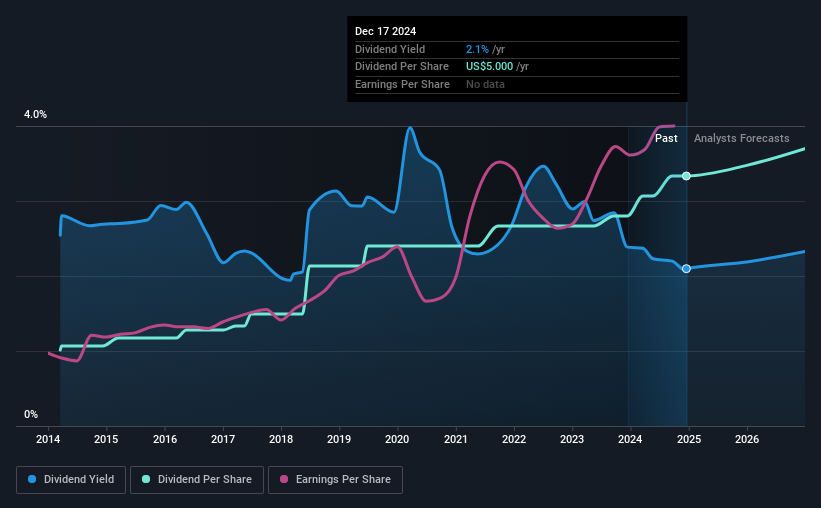
JPMorgan Chase & Co. (NYSE:JPM) will pay a dividend of $1.25 on the 31st of January. Even though the dividend went up, the yield is still quite low at only 2.1%.
Check out our latest analysis for JPMorgan Chase
JPMorgan Chase's Payment Expected To Have Solid Earnings Coverage
The dividend yield is a little bit low, but sustainability of the payments is also an important part of evaluating an income stock.
JPMorgan Chase has established itself as a dividend paying company with over 10 years history of distributing earnings to shareholders. Taking data from its last earnings report, calculating for the company's payout ratio shows 26%, which means that JPMorgan Chase would be able to pay its last dividend without pressure on the balance sheet.
Over the next 3 years, EPS is forecast to expand by 6.6%. Analysts forecast the future payout ratio could be 29% over the same time horizon, which is a number we think the company can maintain.

JPMorgan Chase Has A Solid Track Record
Even over a long history of paying dividends, the company's distributions have been remarkably stable. The dividend has gone from an annual total of $1.52 in 2014 to the most recent total annual payment of $5.00. This works out to be a compound annual growth rate (CAGR) of approximately 13% a year over that time. We can see that payments have shown some very nice upward momentum without faltering, which provides some reassurance that future payments will also be reliable.
The Dividend Looks Likely To Grow
Some investors will be chomping at the bit to buy some of the company's stock based on its dividend history. We are encouraged to see that JPMorgan Chase has grown earnings per share at 13% per year over the past five years. With a decent amount of growth and a low payout ratio, we think this bodes well for JPMorgan Chase's prospects of growing its dividend payments in the future.
We Really Like JPMorgan Chase's Dividend
Overall, a dividend increase is always good, and we think that JPMorgan Chase is a strong income stock thanks to its track record and growing earnings. Distributions are quite easily covered by earnings, which are also being converted to cash flows. All in all, this checks a lot of the boxes we look for when choosing an income stock.
Companies possessing a stable dividend policy will likely enjoy greater investor interest than those suffering from a more inconsistent approach. Still, investors need to consider a host of other factors, apart from dividend payments, when analysing a company. For example, we've picked out 1 warning sign for JPMorgan Chase that investors should know about before committing capital to this stock. If you are a dividend investor, you might also want to look at our curated list of high yield dividend stocks.
New: Manage All Your Stock Portfolios in One Place
We've created the ultimate portfolio companion for stock investors, and it's free.
• Connect an unlimited number of Portfolios and see your total in one currency
• Be alerted to new Warning Signs or Risks via email or mobile
• Track the Fair Value of your stocks
Have feedback on this article? Concerned about the content? Get in touch with us directly. Alternatively, email editorial-team (at) simplywallst.com.
This article by Simply Wall St is general in nature. We provide commentary based on historical data and analyst forecasts only using an unbiased methodology and our articles are not intended to be financial advice. It does not constitute a recommendation to buy or sell any stock, and does not take account of your objectives, or your financial situation. We aim to bring you long-term focused analysis driven by fundamental data. Note that our analysis may not factor in the latest price-sensitive company announcements or qualitative material. Simply Wall St has no position in any stocks mentioned.
About NYSE:JPM
Flawless balance sheet with solid track record and pays a dividend.
Similar Companies
Market Insights
Community Narratives




